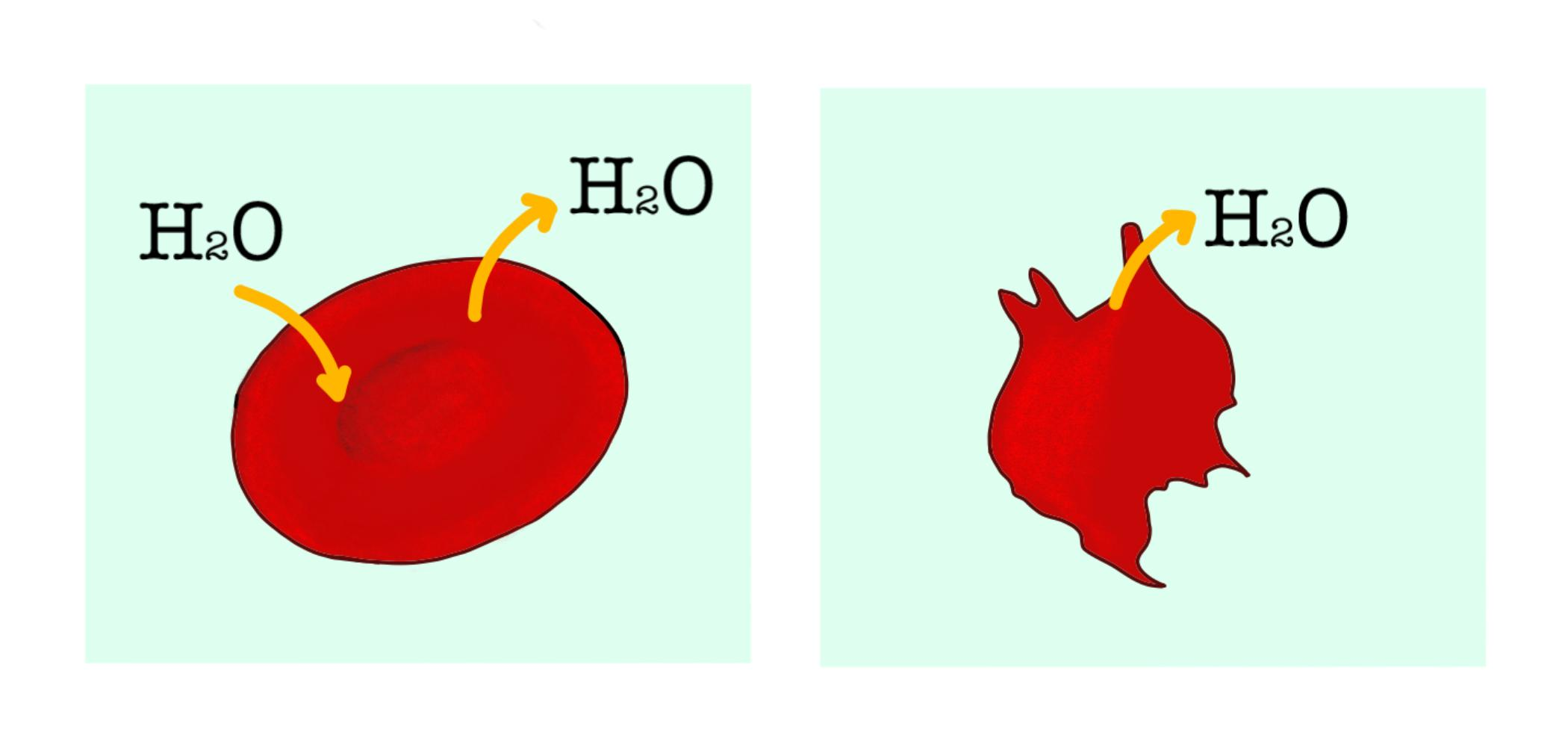
Answer
441.6k+ views
Hint: As seen in the figure A, the ${ H }_{ 2 }O$ molecule is seen going in and out of the red blood cell, in its intact shape. In figure B, ${ H }_{ 2 }O$ is seen leaving the cell and the cell shape looks abnormal. Hence, the entry and exit of water from the cell is a phenomenon that explains the change in the cell shape.
Complete answer:
The red blood cell in the figure is seen to undergo osmosis. Osmosis is defined as the movement of water from a high water potential to low water potential.
- When a cell is present in a solution, osmosis occurs to and from the cell and the solution.
- When the solution outside the cell has a higher concentration than the medium inside the cell, the solution is hypertonic which causes the water from the cells to flow to the solution to create equal osmotic pressure. When the solution outside the cell has a lower concentration than the medium inside the cell, the solution is hypotonic which causes water from the solution to flow through the membrane inside the cell.
- When the concentration of the solution both inside and outside the cell are equal, there is no flow of the water or solvent molecules making the solution isotonic.
- When the solution outside the red blood cell is hypertonic, the water moves from within the cell to outside the cell, resulting in plasmolysis and thus shrinkage of the cell.
Additional Information:
The osmotic pressure is the pressure applied to a solution to stop the flow of solvent through a semipermeable membrane.
- When the red blood cell is placed in a hypotonic solution, the water moves from the outside of the cell into the inside, resulting in the swelling of the cell making it turgid.
- Red blood cells or any physiological cells need to be placed in a medium with an isotonic concentration, or else it leads to swelling or shriveling of cells, which may result in permanent damage.
Note: There are organisms that can survive in high salt environments without facing the loss of water through osmosis. They are known as halophiles.
- Halophiles are of two kinds. Obligate halophiles can only survive in high salt concentration environments while facultative halophiles are able to survive in both high and normal salt concentration environments.
Complete answer:
The red blood cell in the figure is seen to undergo osmosis. Osmosis is defined as the movement of water from a high water potential to low water potential.
- When a cell is present in a solution, osmosis occurs to and from the cell and the solution.
- When the solution outside the cell has a higher concentration than the medium inside the cell, the solution is hypertonic which causes the water from the cells to flow to the solution to create equal osmotic pressure. When the solution outside the cell has a lower concentration than the medium inside the cell, the solution is hypotonic which causes water from the solution to flow through the membrane inside the cell.
- When the concentration of the solution both inside and outside the cell are equal, there is no flow of the water or solvent molecules making the solution isotonic.
- When the solution outside the red blood cell is hypertonic, the water moves from within the cell to outside the cell, resulting in plasmolysis and thus shrinkage of the cell.
Additional Information:
The osmotic pressure is the pressure applied to a solution to stop the flow of solvent through a semipermeable membrane.
- When the red blood cell is placed in a hypotonic solution, the water moves from the outside of the cell into the inside, resulting in the swelling of the cell making it turgid.
- Red blood cells or any physiological cells need to be placed in a medium with an isotonic concentration, or else it leads to swelling or shriveling of cells, which may result in permanent damage.
Note: There are organisms that can survive in high salt environments without facing the loss of water through osmosis. They are known as halophiles.
- Halophiles are of two kinds. Obligate halophiles can only survive in high salt concentration environments while facultative halophiles are able to survive in both high and normal salt concentration environments.
Recently Updated Pages
10 Examples of Evaporation in Daily Life with Explanations

10 Examples of Diffusion in Everyday Life

1 g of dry green algae absorb 47 times 10 3 moles of class 11 chemistry CBSE

What is the meaning of celestial class 10 social science CBSE

What causes groundwater depletion How can it be re class 10 chemistry CBSE

Under which different types can the following changes class 10 physics CBSE

Trending doubts
Fill the blanks with the suitable prepositions 1 The class 9 english CBSE

Which are the Top 10 Largest Countries of the World?

How do you graph the function fx 4x class 9 maths CBSE

Differentiate between homogeneous and heterogeneous class 12 chemistry CBSE

Difference between Prokaryotic cell and Eukaryotic class 11 biology CBSE

Change the following sentences into negative and interrogative class 10 english CBSE

The Equation xxx + 2 is Satisfied when x is Equal to Class 10 Maths

Why is there a time difference of about 5 hours between class 10 social science CBSE

Give 10 examples for herbs , shrubs , climbers , creepers





